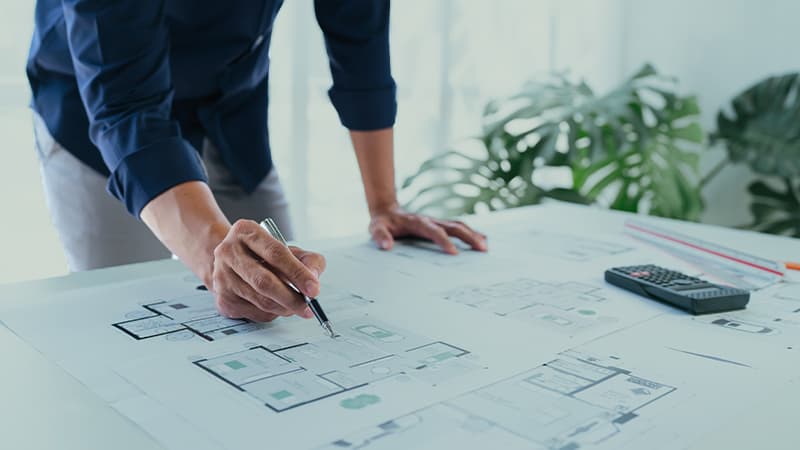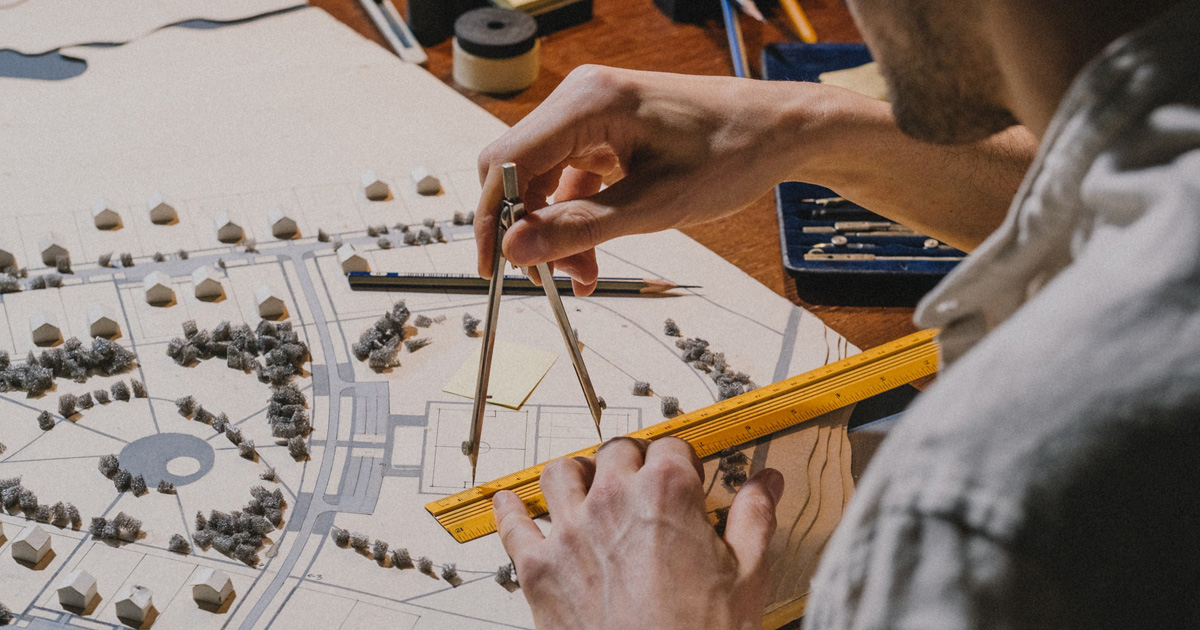Architect Insights on Balancing Form and Function
Architect Insights on Balancing Form and Function
Blog Article
Understanding the Diverse Occupation Paths Available for Aspiring Architect
As a hopeful Architect, you have a world of occupation paths waiting for you. Whether you're attracted to standard architecture or the nuances of lasting style, there's a niche that aligns with your passions.
Typical Style: Creating Frameworks and buildings
Standard design concentrates on developing structures and frameworks that blend capability with aesthetic appeal. Your designs can reflect cultural heritage, showcasing local practices while satisfying modern-day needs.
You'll create skills in composing, model-making, and site analysis, enabling you to picture and connect your ideas efficiently. Engaging with clients, you'll need to comprehend their vision and translate it into viable designs.
Additionally, developing codes and sustainability practices are essential in your work, ensuring your structures are ecologically friendly and risk-free. As you grow in your occupation, you'll find chances in property, industrial, or perhaps repair tasks, each offering special challenges. Embracing standard design leads the way for a satisfying job that admires the past while forming the future.
Urban Preparation: Forming Communities and Public Spaces
As an aspiring Architect, you can play a crucial role as an urban planner, transforming exactly how communities communicate and function. By using community engagement methods, you'll assure that homeowners have a voice in shaping their setting. Plus, integrating lasting style principles will help develop areas that not just satisfy today's needs but also shield the future.
Function of Urban Planners
While numerous may think of designers as the single enthusiasts behind buildings, metropolitan planners play a crucial duty in forming the more comprehensive landscape of communities and public rooms. By collaborating with numerous stakeholders, you'll help create parks, transport systems, and residential areas that promote social communication and availability. Your competence in spatial style and area characteristics allows you to imagine future growth while maintaining social heritage.
Area Interaction Techniques
Effective area interaction methods are essential for urban planners to assure that the voices of homeowners are listened to and valued in the preparation process. To cultivate significant discussion, you should prioritize open forums and workshops where neighborhood members can express their concepts and concerns. By proactively incorporating and paying attention responses, you'll create areas that show the area's requirements, eventually leading to even more effective and lasting city environments.
Lasting Design Principles
When developing city rooms, including lasting design concepts is vital for producing atmospheres that prosper both ecologically and socially. You ought to start by concentrating on power performance, making use of materials that decrease waste and promote recycling. Consider integrating green rooms, like yards and parks, to improve biodiversity and improve air high quality. Promoting walkability and public transport can minimize reliance on cars and trucks, promoting a healthier community.
Designing with water preservation in mind is likewise essential-- consider rainfall gardens and absorptive surface areas to manage stormwater. Including area members throughout the planning process guarantees that the rooms you create meet their needs and urge social interaction. By welcoming these principles, you'll contribute to vivid, sustainable metropolitan landscapes that benefit everybody.

Landscape Architecture: Developing Sustainable Outdoor Environments
As you explore landscape design, you'll uncover crucial design concepts that create attractive and functional outdoor rooms. Lasting techniques play a crucial function in ensuring these environments prosper while minimizing environmental impact. Plus, you'll locate a range of career opportunities that permit you to make a genuine difference in just how individuals interact with nature.
Layout Concepts in Landscape
Understanding style concepts in landscape architecture is vital for developing lasting outdoor settings that integrate with nature. You'll require to consider aspects like proportion, scale, and balance to ensure your styles really feel cohesive and welcoming. Integrating indigenous plants not just improves biodiversity yet also lowers water use, making your landscape resilient. Think about the flow of room and just how individuals connect with it; pathways and seating locations ought to invite expedition and relaxation. Furthermore, take note of seasonal adjustments, developing with products that enhance the surroundings year-round (Architect). By focusing on sustainability and aesthetic appeals, you can produce outdoor spaces that enhance the area and advertise health. Accepting these concepts will certainly establish a solid foundation for your job in landscape architecture.
Sustainable Practices Review
Sustainable practices in landscape style not just concentrate on looks however likewise prioritize ecological health and wellness and source preservation. By incorporating native plants, you enhance biodiversity and minimize the need for chemical fertilizers and chemicals. Applying reliable watering systems assists conserve water and lessens runoff, protecting neighboring communities. You can develop rooms that advertise dirt health and wellness, such as practicing and making use of organic products permaculture principles. Additionally, including green infrastructure, like rain gardens and porous pavements, help in stormwater management and decreases urban warmth. When you produce exterior atmospheres with sustainability in mind, you add to a healthier world and supply spaces that cultivate neighborhood link. Eventually, these practices guarantee your styles profit both individuals and the atmosphere for several years ahead.
Career Opportunities Expedition
With a strong foundation in sustainable practices, landscape architecture offers a range of career courses that allow you to make a purposeful effect on the setting. You could work as a landscape developer, producing cosmetically pleasing and practical outdoor areas, or concentrate on ecological remediation, assisting to revive broken ecosystems. Urban coordinators typically work together with landscape engineers to produce eco-friendly rooms in metropolitan setups, improving city livability. If you're passionate concerning education, take into consideration ending up being a landscape style teacher, motivating future generations. In addition, you may function with nonprofits focused on environmental sustainability or engage in research study to introduce new techniques. Each path not only forms gorgeous atmospheres yet likewise promotes a much healthier planet for future generations.
Sustainable Layout: Concentrating On Eco-Friendly Practices
As you explore your job in style, accepting eco-friendly practices can set you apart in a competitive area. Sustainable style concentrates on creating buildings that decrease ecological impact while boosting resident wellness. By integrating eco-friendly materials, energy-efficient systems, and sustainable building strategies, you'll contribute to a greener future.
Begin by gaining expertise of green certifications like LEED or BREEAM, which can boost your qualifications. Take into consideration just how natural light, ventilation, and thermal efficiency can maximize design. Collaborate with engineers and environmental specialists to introduce solutions that reduce waste and save resources.
Do not forget the relevance of area involvement-- engaging neighborhood stakeholders can inspire designs that balance with the setting. As customers increasingly focus on sustainability, your competence in green methods will not only draw in projects yet also satisfy your passion for responsible architecture. Accept this important aspect of the occupation, and watch your job flourish.
Historic Conservation: Shielding and Bring Back Cultural Heritage
While you start original site on your building trip, take into consideration the important role of historic preservation in maintaining our social heritage. This field concentrates on the protection and remediation of significant structures, sites, and structures that inform the stories of our past. By taking part in historical conservation, you'll aid guard the building legacy that forms community identity.
As a historical conservation Architect, you'll assess historical value and analyze the condition of frameworks. You'll function carefully with conservationists and historians to guarantee genuine restoration strategies are used. This occupation path allows you to mix creative thinking with research, enabling you to create remedies that appreciate initial materials and craftsmanship.
Your job not just adds to sustainability by recycling existing structures however additionally cultivates a sense of pride within neighborhoods. Welcoming this path will certainly assist you become a guardian of history, maintaining the tales and visual appeals that enhance our lives.
Inside Architecture: Enhancing Indoor Spaces
Historical conservation and indoor design both share a commitment to boosting the built setting, however they concentrate on different facets. While historic conservation highlights keeping a structure's historic and cultural worth, indoor architecture absolutely nos in on optimizing indoor spaces for performance and aesthetic appeals.
As an ambitious Architect, you'll find that indoor style allows you to blend creativity with technological abilities. You'll make areas that not just look good yet additionally advertise convenience and performance. This field entails comprehending exactly how light, color, and materials interact within an area, influencing state of mind and functionality.
You'll deal with different tasks, from domestic homes to business offices, guaranteeing that each setting meets the needs of its passengers. By focusing on user experience, you can transform interiors into motivating and practical areas, making a substantial effect on just how individuals engage with their environments. Welcome the opportunity to Recommended Reading improve indoor atmospheres and form the way people live and function.
Industrial Style: Combining Performance With Aesthetics
Commercial layout plays a crucial duty in producing items that seamlessly blend appearances with functionality, ensuring that what you utilize day-to-day is not just visually enticing but additionally practical. As an aspiring Architect, you can immerse on your own in this field, focusing on developing everything from furnishings to consumer electronics. Your work involves comprehending customer needs, products, and manufacturing processes, allowing you to create cutting-edge remedies that enhance everyday experiences.
In industrial layout, you'll often work together with designers, makers, and marketing professionals, making certain that your designs are not just stunning but additionally practical. You'll find out to balance kind and function, focusing on functionality without sacrificing style. By developing your abilities in mapping out, 3D modeling, and prototyping, you'll be fully equipped to bring your concepts to life. This job course provides a dynamic setting where imagination meets usefulness, making it a satisfying option for architects thinking about shaping the items of tomorrow.
Often Asked Questions
What Educational Qualifications Do I Required to Come To Be an Engineer?
To come to be an engineer, you'll need an expert level in design, normally a Bachelor's or Master's. In addition, you'll need to finish a teaching fellowship and pass the Architect Registration Assessment to exercise lawfully.
Exist Qualification Demands for Different Building Occupation Paths?
Yes, there're certification needs for different building paths. Architect. You'll need to pass tests, complete teaching fellowships, and often pursue specialized training, depending upon your chosen focus, like landscape design, urban style, or historical preservation
What Software Program Skills Are Essential for Engineers Today?

How Can I Gain Practical Experience While Researching Design?
You can gain functional experience by interning at architectural firms, joining layout competitors, offering for area projects, or working together with schoolmates on real-world jobs. These chances improve your skills and build beneficial links in the industry.
What Task Opportunities Exist Outdoors Standard Style Firms?
You can check out various work opportunities outside standard architecture firms, like city planning, interior decoration, landscape architecture, building monitoring, realty advancement, or perhaps roles in sustainability consulting. Each offers look here special challenges and benefits.
Whether you're attracted to conventional style or the nuances of sustainable layout, there's a niche that straightens with your passions.When making urban spaces, integrating lasting layout concepts is crucial for creating environments that flourish both ecologically and socially.As you check out landscape style, you'll uncover crucial layout principles that develop useful and lovely outside rooms.Comprehending style concepts in landscape design is necessary for developing lasting outdoor environments that integrate with nature.In commercial layout, you'll usually team up with producers, online marketers, and engineers, ensuring that your designs are not only gorgeous but additionally feasible.
Report this page